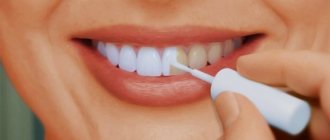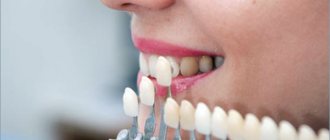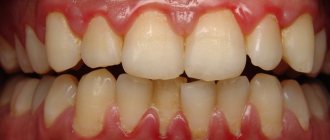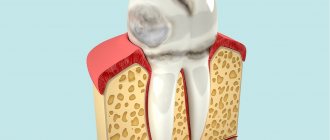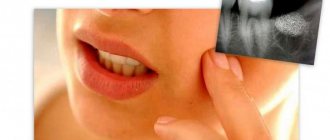3492
In the understanding of most patients, dental prosthetics is the implantation of a structure consisting of a coronal zone that can qualitatively replace a natural organ, both in terms of external and functional indicators.
During the implantation process, a root part will be added to the crown, which is localized in the deep layers of bone tissue.
At the same time, few people know that in a number of clinical situations the system requires the presence of another additional element.
General overview
In addition to maximally matching the color of the prosthesis with natural organs, the doctor tries to achieve a natural appearance of the soft tissues of the mucosa. This can be done using artificial gums. At the same time playing the role of a supporting base structure, it also performs an aesthetic function.
The formation of this device can restore the jaw row to its former attractiveness even in the absence of a large number of dental units.
Very often, such negligence as untimely restoration leads to severe atrophy of both soft tissue and hard spongy fragments of the gums in those places where there are voids.
In this situation, the use of artificial gums will become not only the most gentle and fastest, but also a financially accessible measure in comparison, for example, with the procedure for building up hard bone areas.
Artificial gum for prosthetics and basal implantation
Bone augmentation and transplantation in some cases make it possible to do without the use of artificial gums, but such operations significantly prolong the healing period and delay the moment when the patient can again smile broadly and chew without fear of pain and discomfort.
The evolution of basal implantation has allowed clients of dental clinics to receive a full set of teeth literally 2-3 days after treatment, however, in this case, small areas of tissue atrophy will necessarily be compensated for by artificial material.
If during implantation the ceramic area acts as a lining, then the artificial gum during prosthetics is a full-fledged functional element. In this case, it is part of the prosthesis structure, which, when worn, rests against natural soft tissue. This part of the prosthesis design is otherwise called the base.
Relying on the patient’s own gums, it ensures not only stabilization of the position of artificial teeth, but also uniform distribution of the load on the jaw.
Before installing dentures, the doctor carefully selects the color of the ceramic material so that it matches the shade of the patient’s mucous membrane. Thus, the artificial areas are invisible when smiling and are no different from the surrounding tissue. In addition, a tighter fit and zero probability of injury to the ceramic gum reduces the risk of inflammation, which is important in the post-implantation period.
The surgeons at Dr. Kizim Dental Center have extensive experience in the field of basal implantation, prosthetics and aesthetic surgery. Accurate selection of shades, use of high-quality materials, careful work with the patient, flexible prices are recognized advantages of the clinic. Find out how to get a perfect smile in three days on our website or contact our dental center right away. Waiting for you!
Types of prostheses
Based on the design features of products used in orthopedic practice for the restoration of lost dental units, the following types of devices are used:
- removable systems with the presence of artificial gums - full structures are fixed using a suction effect, partially full ones - using clasps on the supporting teeth. They have a hard crown part and a soft base that imitates gums;
- permanent dentures without this element – mainly bridges or prosthetics on implants.
In the latter case, a temporary system is first installed, which after healing of the soft tissues is changed to a permanent one.It differs from clasp devices in that it does not require preliminary grinding of teeth, can be implanted anywhere in the jaw row and copes with increased loads better than other options;
- permanent type structures with gum - the fragment is formed from ceramics based on zirconium dioxide. The coronal part and fixation are standard and are selected based on anatomical features, patient preferences and specialist recommendations.
Who is recommended for implantation with 6 implants, and the advantages of the method.
Let's talk here about the importance of bone material in dentistry.
At this address https://zubovv.ru/implantatsiya/metodiki/hirurgicheskiy-shablon.html we will talk about the stages of manufacturing a surgical template for implantation.
Gum grafting against “gummy” and “shark” smiles
The gingival contour depends on many factors. Genetics, certain medications, and certain diseases lead to soft tissue hypertrophy. There are too many of them, which is why the teeth appear small, the so-called “shark smile” appears. In this case, gingivectomy is used. It consists of excision of excess tissue, elimination of gum pockets or hood, which occurs, for example, during the eruption of “wisdom teeth”. After excision of excess, the desired soft tissue contour is formed.
Many patients also resort to gum grafting, especially on the front teeth, if they have a gummy smile. It is characterized by the exposure of more than two millimeters of the upper gum when a person smiles, which gives the face a “horse” appearance. In this case, with the help of gum plastic surgery, excess soft tissue is removed from the surface of the teeth, and the gum contour is given a beautiful shape.
Main functions
In removable restorative prosthetic systems, the presence of an artificial element is a mandatory requirement. When the device is simply fixed on the gum, an additionally formed copy of it significantly strengthens the fastening, since it clasps the alveolar as tightly as possible.
In clinical situations involving the implantation of a prosthesis on an implant, in its internal area, precisely in that place, on the back side of the coronal part, there are fixing fragments.
An artificially created copy of the gum will make it possible to hide defects from prying eyes, significantly increasing the overall aesthetic characteristics of the prosthesis.
Dentists often recommend the use of this element even when the patient uses permanent prosthetic devices.
This may cause a person to doubt the competence of their doctor, which is absolutely groundless. In this case, such a former will be able to eliminate the possibility of developing malocclusions, replenishing its height to the norm.
In addition , an artificial gum will be required if the patient’s bone fragments have decreased in size due to too long absence of teeth, and the gingival angle has sharply decreased.
To give the jaw row ideal evenness, basal restoration of organs is used. At the same time, they will be attached to the remaining bone volume, and the missing part will be replaced by the device discussed in this article.
If teeth are lost due to the negative impact of a number of diseases on them , for example, periodontitis or periodontitis, the tissues lose their former strength and undergo the atrophy process extremely unevenly.
To hide this external defect, they also resort to artificial gums.
What is gum grafting?
Gum grafting is performed in a dental office under local anesthesia. It uses both traditional scalpels and laser technologies. The doctor decides what is suitable in your particular case. Often, in order to get a general idea of the result of the procedure, before it begins, the dentist draws the contours of the future position of the gums on the teeth.
The operation is performed by a periodontist. Before deciding on a procedure, carefully select an aesthetic dentistry clinic and find out the competence of your doctor: ask him about his experience and qualifications. Always look into your dentist's continuing education and ask to see examples of work they have already done.
Pros and cons compared to plastic surgery
About plastic
Restoring chewing function through maxillofacial bone grafting is one of the innovative areas of modern dentistry and has certain advantages that, unfortunately, the use of artificial gums cannot provide.
This:
- the ability to completely restore organs to their former functionality, even if the area of atrophic changes is too large;
- the ability to implant implants after the manipulation;
- high aesthetic level of the restoration performed;
- faster process of restoration of chewing abilities.
At the same time, carrying out such operations is ineffective or absolutely impossible for a number of significant indications:
- diagnoses related to diseases of hard tissue fragments, for example, osteoporosis;
- poor blood clotting;
- exacerbation of chronic pathologies of vital systems of the human body;
- any inflammatory abnormalities of the mucous membranes of the oral cavity;
- malignant neoplasms, regardless of the stage of progression of the process.
In addition, this procedure is absolutely useless if the bone structure is excessively loose.
The main advantages of two-stage dental implantation over other methods.
In this publication we will calculate the price of express dental implantation.
Go here https://zubovv.ru/implantatsiya/metodiki/mozhno-li-pri-parodontoze.html if you are interested in whether implantation is possible for periodontal disease.
About dentures with gums
As for the formation of a prosthesis containing a fragment of artificial gum, its use has its main advantages:
- a wide range of applications , including complex clinical cases - even if the patient has completely lost both jaw rows, this type of structure can qualitatively solve the problem of restoration;
- fixation of the system is not associated with physical pain , rehabilitation discomfort, or complications caused by material rejection;
- possibility of choosing hypoallergenic components;
- shorter treatment period – since such models are distinguished by a holistic structure and excellent initial stability.
Instant loading, in the absence of complications, can be given already 2–3 days after the manipulation of the prosthesis installation.And thanks to the normal pressing force of the cells of the bone areas, natural tissues will grow quite quickly in the area surrounding the established system;
- modern materials make it possible to create the lightest possible prosthesis , completely imitating the soft mucosal tissue in color.
The disadvantage of the method can be considered the presence of unnatural components in the production process of a prosthesis with artificial gum, while when growing solid fragments, natural cells of the body are used, which is more natural from a physiological point of view.
Classical implantation with bone tissue augmentation
To install implants of a standard classic type, a sufficient amount of bone tissue is required. In this case, you receive a denture without artificial gums, consisting solely of dental crowns. But you will lose in the following:
- the cost of treatment will increase: since the augmentation operation costs some money, besides, classical implantation is almost twice as expensive as the basal method,
- the treatment period will increase: at least three months are needed to restore the bone after augmentation and the same amount more for the complete engraftment of the implants, only after this it will be possible to install a permanent prosthesis
Process of creation
The step-by-step dynamics of production of a product with artificial gum formation in a denture laboratory is as follows:
- making a diagnostic impression;
- calculating the bite for possible defects in the aspect of volumetric jaw projection;
- measuring the load on organs that will subsequently play a supporting role;
- diagnostic drawing of the future prosthesis;
- grinding and fitting of teeth;
- production of a wax structure based on a plaster cast;
- frame manufacturing, grinding and turning of preliminary blanks;
- obtaining a wax impression of future teeth;
- marginal modeling – it is necessary that the interdental spaces are identical to natural ones.
To do this, the patient partially covers the neck of the organ with a composite, so that the papillae slightly resemble a cushion. These parts will completely fill the voids towards the cutting edge. Moreover, the older a person is, the more the cervical area is exposed.
In the video, a specialist shows how to make artificial gums.
What does a metal-ceramic dental bridge look like?
All fixed bridges are similar in appearance: they consist of a frame and artificial crowns that imitate the visible part of the tooth. Their very name speaks about the features of metal-ceramic “bridges”. They are made of metal and ceramics, that is, the metal base is covered with a layer of ceramics, making the design look quite natural. The base of the prosthesis is made from several types of alloys:
- nickel-chromium
- cobalt-chromium
- based on palladium and silver
- based on gold or platinum
The last two types of alloys are rarely used (especially gold), since they increase the cost of treatment, thereby eliminating one of the main advantages of metal-ceramic prostheses - cost-effectiveness. Theoretically, prostheses made of zirconium dioxide with ceramic lining can also be called metal-ceramic, but almost all experts distinguish between these two technologies.
Requirements
Since the copy should look as aesthetically pleasing as possible, the specialist imitates the vestibular texture, similar to the peel of an orange.
This is done by melting liquid wax using high temperatures using a spatula. As a result, the wax, flowing onto the cold tooth, creates the necessary relief and takes on the desired shape.
The main requirement is that the modeled edge of the workpiece must fill the voids according to the same principle as it happens anatomically in those places where the teeth have retained their integrity and anatomical structure.
This result cannot be achieved by applying the base component too sparingly, which is not only unacceptable from an aesthetic point of view, but also extremely unprofessional.
Poorly filled areas will inevitably collect food debris. This will complicate the care of the prosthesis and can lead to the development of a number of diseases of the oral mucous tissues.
The most accurate selection of the color of the material is another condition for high-quality prosthetics. The high-quality components included in modern mixtures make it possible to achieve almost one hundred percent resemblance to natural soft tissues of the oral cavity.
Gum grafting: healing after surgery
Depending on the type of gum grafting, complete recovery takes from several days to several weeks. Your doctor will give you a list of recommendations to follow after surgery. He will also prescribe painkillers. In general, the recommendations boil down to the following: it is necessary to remain calm and reduce physical activity, eat soft foods at room temperature and avoid spicy foods until the gums are completely restored, and carefully carry out oral hygiene, including rinsing. Until complete healing, you will have to wear a special mouthguard that protects the affected areas from external factors and promotes faster and safer healing.
Swelling after surgery lasts for several days. As a rule, on the third day the swelling may increase, and then subside. If swelling does not go away, severe pain, bleeding or other frightening symptoms appear, you should immediately consult a doctor.
Gum grafting is a surgical procedure, and like any other, it has certain risks. The most common are allergies to the anesthetic and recurrent gum recession. In order to avoid allergies, you should notify your doctor in detail in advance about the presence of any diseases and the occurrence of allergies to medications in the past. In case of relapse, the procedure can be repeated no earlier than six months after the previous one.
Reviews
This technique is used in almost all domestic dental clinics. Its result is the elimination of discomfort, correct bite and excellent aesthetic content.
If you have experienced the pros and cons of this method of prosthetics from your own experience, you can leave your comment in the appropriate section. Undoubtedly, some of our readers will find this useful.
If you find an error, please select a piece of text and press Ctrl+Enter.
Tags artificial gum implantation
Did you like the article? stay tuned
No comments yet
Types of metal-ceramic “bridges”
All bridges are based either on natural teeth or on artificial roots - implants. The former are considered classical type prostheses. Constructions installed on natural teeth are much cheaper than dentures on implants. In addition, the treatment process takes place more quickly: there is no need to wait for the completion of the osseointegration process, which takes up to six months. In all other respects, an implant-supported bridge has a clear advantage. This is a more reliable, durable and aesthetic design: implants prevent bone tissue atrophy, and installation of a prosthesis does not require grinding of teeth. Read more about the method in a separate article.
Implant installation
- Dissection of gum tissue to gain access to the jaw bone and drilling of a narrow canal (up to 2 mm).
- The depth of the narrow channel is checked with a special tool.
- Gradual expansion of the canal using a set of drills to the required diameter.
- Fixing the implant with a power tool.
- Hand twisting.
- Installation of a plug screw, which protects against the penetration of microbes and mechanical irritants.
- Instead of a cover screw, a gum former is installed. This is necessary to create a natural contour around the implant.
- Replacement of the former with a temporary abutment (after 2 weeks). The duration of the procedures is 30-45 minutes.
| How long does the dental implant procedure take? The described stages take an average of 15-20 minutes. |
After these procedures, the doctor sutures the gum and gives the implant time to take root (from 3 to 6 months).
Why is bone augmentation necessary?
Bone augmentation (osteoplasty, sinus lift, bone replenishment) is the process of replenishing hard bone in the area where a dental root-shaped implant is subsequently planned to be installed.
Why is it important to build bone tissue? Because due to the absence of a tooth in the socket for a long time, the bone gradually decreases, and future implantation, in fact, loses its meaning. If there is not enough bone tissue, over time the implant loses its stable position, and the risk of rejection is high - all the work on its installation will have to be redone, again incurring financial losses and experiencing moral and physical risks.
Note! Sometimes bone grafting is required due to the physiological characteristics of the human jaw structure. Also, due to the fact that the bone decreases, inflammation of the soft tissues occurs (periodontitis, periodontitis).
The roots are located in the so-called alveolar processes, that is, the spongy part of the bone. Tooth roots constantly keep this area in good shape, active blood circulation occurs. In the absence of a tooth, the pressure on the jaw stops; accordingly, the bone tissue dissolves, resorption (loss) of the jaw bone occurs, and atrophy of the alveolar process occurs.
Bone tissue augmentation involves supplementing it with material that activates natural growth. Thus, the new bone is strengthened, its volume increases to the desired size.
Dentistry for those who love to smile
+7
Make an appointment
Materials and manufacturers
In the manufacture of implantation systems and auxiliary products, medical titanium, stainless steel, and other metal alloys are used. For installation in the frontal zone, there are models made of zirconium that are not visible through the gum tissue. Manufacturers offer different models of shapers. The doctor selects an option according to the clinical situation. The classification is based on the shape, size and type of part. The line includes standard, narrow, and wide models.
Standard ones are used in cases involving a translingual method of intervention, when correction of the mucous membrane is carried out immediately before installation of the implant. Markers are applied to the surface of the element, allowing you to control the level of fouling of soft tissue. If the diameter of the prosthetic structure is more than 5 mm, wide models are used, if less than 5 mm, narrow models are used.
The most famous manufacturers of implantation systems and components for them:
- NSK (Japan)
- Nobel Biocare (USA)
- Astra Tesh (Sweden)
- Trate AG (Switzerland)
- Bicon (USA)
- Niro (Germany)
- Semantos (Germany)
- Impro (Germany)
- Adin (Israel)
- Alpha Bio (Israel)
- NeoBiotech (South Korea)
Of course, the list is not limited to the brands listed. The cost of placing a gum former depends on the material, brand, technical parameters, and size of the superstructure. For good results, it is recommended to install implants and auxiliary components from the same manufacturer.
The network of RUTT clinics in Moscow uses Swiss implantation systems and ROOTT superstructures produced by Trate AG. All components are made of the same grade of titanium and fit perfectly due to their exact size. This is a universal, reliable implantation system, the effectiveness of which is scientifically proven.
Installation of metal-ceramic dental bridges
Stage 1 - consultation.
During the first visit to the doctor, anamnesis is collected and the rehabilitation method is agreed upon.
Stage 2 - rehabilitation.
Preparation of the oral cavity, treatment of concomitant dental diseases, if any.
Stage 3 - production of the prosthesis.
Computer modeling is considered the most advanced and most accurate method for manufacturing orthopedic structures. In the case of metal ceramics, a metal frame is first made, and after applying the ceramics, the product is fired.
Stage 4 - implantation.
If the product is fixed on implants, a surgical stage is necessary. A classic denture requires grinding of adjacent teeth.
Stage 5 - installation.
Fitting and installation of the finished structure.
Orthopedic stage
Final stage. Fixation of a crown or fixed prosthesis (on 4 or 6 implants). The method of fixation depends entirely on the chosen design. For example, the prosthesis is attached to screws, which are screwed through special holes and then masked.
| Is it painful to get a dental implant? No. All work, starting with bone grafting, is performed under local anesthesia, the composition of which is selected individually. Our patients feel as comfortable as possible. |
At the “Dr. Fedorov Implantation Center,” the doctor, even at the preparatory stage, tells the patient how dental implants are placed and informs about the features of the upcoming operation. The first consultation with an implant surgeon is free.
Advantages and disadvantages
- Good functional performance.
- Aesthetics are above average.
- Low cost (except for prostheses on implants).
- Reliability and durability of the design (a classic prosthesis lasts an average of 7 - 8 years, with implant support - 15 or longer).
- The possibility of allergic reactions in the patient.
- Additional contraindications associated with the presence of metal in the prosthesis.
- Installation in the smile area is not recommended, since metal elements can shine through the ceramics; over the years, a noticeable blue line appears at the junction of the gum and the prosthesis.
“Like a native”: the whole truth about dental implants.
“Like a native”: the whole truth about dental implants.
Many people already know firsthand about the advantages of implants over other methods of dental prosthetics. However, those who are just thinking about it ask questions: is it possible to install an implant in one visit, what is bone grafting, is it necessary to correct the bite before implantation, and what is it like to “live with an implant” after all? These questions will be answered by the guest of our regular column - Elena Evgenievna Shchepetnova - candidate of medical sciences, orthopedic dentist, surgeon, head of the dental department of the Alexandria clinic.
Elena Evgenievna, good afternoon. Recently, there has been frequent talk about simultaneous implantation. It turns out that there is no need to wait for the implant to take root? Please comment.
The classic method is used when the tooth has been removed and at least 3 months have passed. This method has advantages - the gums have healed and the bone tissue under the mucous membrane is sterile. The prognosis for implantation is the best. The disadvantages are the timing. With the classic method, after installing the implant, at least 3-4 months must pass, it must be overgrown with gum, only then we make an incision and screw a crown onto the implant. Immediate implantation method - we remove the tooth and immediately place an implant in the hole. The method is good, but it is only suitable for single-rooted teeth. Another disadvantage is that the implant is placed in an infected socket, the likelihood of complications is much higher. We take such risks when the tooth is an anterior one and the patient does not want or cannot walk for a long time without the front tooth, but in any case the doctor evaluates the risks! I will add that during immediate implantation, we make the temporary crown of the tooth a little shorter to remove the stress from it.
Is it true that if you have a malocclusion, you can’t get implants?
The presence of bite pathology is a local contraindication for implantation. If the bite is incorrect, the load on the implant will be inadequate and it may become loose. Before placing an implant, the bite must be corrected. General contraindications to implantation are general systemic blood diseases, for example, anemia, diabetes, etc., oncopathologies, acute conditions. Another local contraindication is the lack of bone tissue, which should completely “encircle” the implant.
What to do if there is not enough bone tissue?
Bone tissue needs to be built up. You can increase the width and height - this is bone grafting; increasing the height in the upper jaw is called sinus lifting. When augmentation is performed by a doctor, an oral and maxillofacial surgeon, a “pocket” is created into which the material for “adding” bone tissue is placed—synthetic membranes, or the patient’s own “donor” bone tissue, for example, from another jaw. Your own fabric is, of course, preferable. Building bone tissue is a long process, up to about six months.
How to avoid complications? What can reduce the risk of implant failure?
In any case, a course of antibiotics is prescribed after the operation. Without this, the risk of rejection increases. Before the operation, we always conduct blood tests for almost all major pathologies, but we can only learn about any other problems from the patient. It is important that the patient tells the doctor about existing diseases. Poor hygiene is the cause of 50% of implant failures. It happens that the implant does not take root for an unknown reason, then we return it to the manufacturer and install a new one for the patient.
By the way, about hygiene. How to properly care for implants?
I usually tell my patients: “Clean your implants twice as good as your teeth.” Why is that? The fact is that your tooth is suspended in the socket by ligaments and it is slightly mobile; there is a ligamentous apparatus between the tooth and the bone tissue. And even if you haven’t brushed your teeth several times, this ligamentous apparatus will not immediately respond to possible inflammation. The implant is tightly covered with bone tissue, it grows into it. If you don't brush your teeth a couple of times, the infection can get right into the bone tissue, the implant can become loose and will have to be removed. If you strictly observe hygiene, there are no problems. There are special brushes and irrigators (dental showers) - you will have to use these. And once every six months, do professional oral hygiene.
Tell us about the all-on-four implantation technology. Who can she help?
It happens that the patient has no teeth at all. As a rule, these are elderly people. And in the usual case, we make a removable denture for such a patient. It should be removed at night and after eating. It's unpleasant, inconvenient. All-on-four technology is an alternative. Despite the fact that atrophy of the bone tissue necessary for implantation occurs with age in everyone, there are areas where the bone tissue remains in good shape for a long time and it is almost always possible to install implants there for everyone. We place implants in these areas and then place a permanent prosthesis on them; the patient will have an open palate.
Clinics often offer “implantation using a surgical template.” What is this?
In difficult cases, it may be difficult for the surgeon to place the implant in the correct position, so that later a beautiful and functional crown is obtained; for this, before the operation, a special template is made based on the results of a computer image, with the help of which the doctor determines the optimal location for installing the implant. This makes the surgeon’s job easier and increases the chances of correct implant placement. After all, if the implant is installed crookedly, the crown will not fit on it and will have to be drilled out.
Implants are made of titanium. What materials are currently used for crowns? What to choose?
Two materials that deserve attention are metal ceramics (metal inside, porcelain outside) and zirconium oxide - this more aesthetic material can be called “metal-free” ceramics, i.e., without a metal frame. Over time, the gums may “sink”, then the edge of the metal base of the crown will become visible, which is not very aesthetically pleasing, especially if the tooth is an anterior one. Zirconium oxide does not have this problem; moreover, this material is hypoallergenic, but it is not suitable for the manufacture of large bridges - it is more fragile.
What is the cost of implantation? How much does a turnkey tooth cost on average in Nizhny Novgorod?
The price of the implant itself consists of the price of the material and methods of its processing. The implant itself is the root of the tooth. It needs a counter part - the so-called superstructure, on which the crown is attached. It must be from the same manufacturer. The price also depends on the quality of the connection between the superstructure and the implant. The more expensive the system, the better the quality of connections, this is actually true. The covering part, the crown, is already made in clinic laboratories. On average in the city at present, installing an implant, including the work of a doctor, costs approximately 21,000 rubles or more. The crown will cost the same. Cheaper is already suspicious.
What is basal implantation?
With basal implantation, plate implants were initially used, which were held in the gum due to their shape, and not due to the fact that bone tissue grew into them, as is done with more modern, classic implants. The point is also that bone grafting (bone tissue augmentation) is not always possible - either there is nowhere to get bone tissue, or there are contraindications. This is traumatic and expensive. Basal implantation may be a solution, but I would not recommend it. In itself, it is a thing of the past, but there are supporters, new basal implants have appeared, more advanced ones, but the technique has not been tested by time. Let's wait and see... I note that bridges and removable dentures have not been canceled, they are now beautiful, with locks, and they are not visible at all. Modern dentistry has many ways to make your smile beautiful and bring comfort back to your life.
Interviewed by Danila Rezak.
